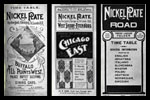 Railroads, East St. Louis, and the American Bottom
Railroads, East St. Louis, and the American Bottom
 |
| Flyers advertising the Nickel Plate Rail Road |
Railroads became the lifeblood of East St. Louis beginning in the 1840s.
In this regard the American Bottom region was at the forefront of change
in America. Just as steam power opened the country's waterways to
transportation, railroads made land travel faster than it had ever been.
Railroads opened America up as never before; people traveled across the
land in great numbers, they moved to the edge of rural areas and further
because train tracks offered them a link back to the cities;
 |
| Photograph of a Nickel Plate Dynamometer Car from the
1890s |
goods and materials could reach formerly isolated places and the time to
deliver them shortened; towns and cities thrived or suffered depending
on the presence of rail transportation. Cities and towns where railroads
laid tracks often boomed into commercial transportation centers.
Rail transportation came in the midst of the industrial revolution, so
not only did it offer a new fast and efficient means of transport, there
were more goods to move along tracks. East St. Louis played a significant
role in the movement of goods and people across the country.
 |
| Early photograph of the Eads Bridge |
RiverWeb offers you a glimpse at some of these developments. You
can follow the history of rail development in America and learn how East
St. Louis fits in, you can learn about the construction of the Eads bridge
and its importance to rail transportation, or you can trace the history
of the Nickel Plate Rail Road, one of the many companies that laid tracks
in East St. Louis.
 Railroads, East St. Louis, and the American Bottom
Railroads, East St. Louis, and the American Bottom Railroads, East St. Louis, and the American Bottom
Railroads, East St. Louis, and the American Bottom

